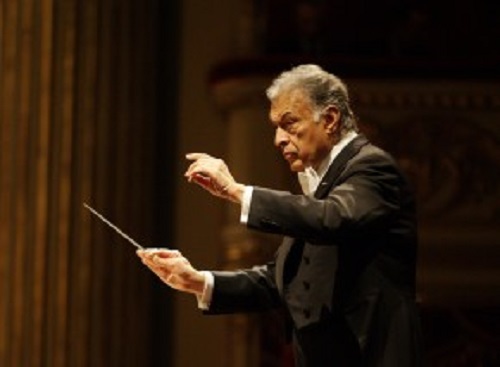 United States Brahms [II]: Pinchas Zuckerman (violin), Amanda Forsyth (cello), Los Angeles Philharmonic / Zubin Mehta (conductor), Walt Disney Concert Hall, Los Angeles. (DD)
United States Brahms [II]: Pinchas Zuckerman (violin), Amanda Forsyth (cello), Los Angeles Philharmonic / Zubin Mehta (conductor), Walt Disney Concert Hall, Los Angeles. (DD)

4.1.2019 – Violin Concerto in D major Op.77; Symphony No.3 in F major Op.90
5.1.2019 – Concerto for Violin and Cello in A minor Op.103; Symphony No.4 in E minor Op.98
Someone in the programming office of the LA Phil should be proud for having scheduled the balanced, intelligent – and risky – performances of the four Johannes Brahms concertos paired with his four symphonies. The concerts took place during the seasonal events of Hanukkah, Christmas, New Year’s Day and the Twelfth Day of Christmas, and each one felt like a gift. The formal design was rudimentary – one concerto and one symphony set off by one intermission and, when appropriate, one encore. It’s a simple formula but, in this case, it is the stuff that music dreams are made of.
In December, I reviewed the first two concerts, which featured Yefim Bronfman at the piano (click here). This second Brahms set paired Symphonies No.3 and No.4 with the two non-piano concertos – solo violin and violin/cello – and were performed during the first week of January. Just as in the earlier concerts, there was an interior logic to the structure and presentation, particularly in the congruence between their respective modalities: the first of the two were set in sunny, major modalities, while the later pieces close in darker, minor modes. I adore both concertos but have long felt that the Double Concerto was as serious a work in the Brahms repertoire as one could rightfully expect (and hope for).
All of Brahms’s large-scale musical endeavors are built on a serious and sober stage, and while the most melancholy passages grasp an ideal of hope, his most triumphant segments are shaped with strains of loss and hints of mortality. What’s not to love?
The first evening began with the Violin Concerto in D major, a masterpiece that takes its rightful place with the worthiest in the violin repertory. Pinchas Zuckerman has long owned this piece, and he did not disappoint. The drama and emotion of the work are evident within the first 16 measures, but the real compositional artistry is best displayed in the second movement, the Adagio. Most of the opening music consists of melodically outlining the harmonies, but in setting up such a calm, simple environment Brahms succeeds in squeezing out every bit of sorrow and regret – and love? – that live in this music. Zuckerman’s performance was reliably full and rich (as it has been for the last four decades) and, as always, he played without sentimentality or schmaltz. These are among the defining qualities of this violinist. Under a seated Zubin Mehta – honored before the concert as Conductor Emeritus – the orchestra was equally circumspect, allowing the emotion to express itself without any unnecessary nudging or emoting from the interpreters.
Brahms’s Symphony No.3 is arguably his most ebullient, beginning with the great three-chord opening and continuing with a melody of vast range and continuous motion. This movement is often compared with Robert Schumann’s ‘Rhenish’ Symphony (a comparison I find undeniable), and though full of activity and turbulence, it ends on a soft note. Indeed, all the movements in this sometimes-enigmatic masterpiece end thusly.
The piece is a study in enigma, and yet the design makes perfect sense. The moods change with regularity, but this is just what Brahms does. The orchestra is as closely knit as an organization of this size and complexity can be, and special attention should be paid to principal horn Andrew Bain, associate principal Jaclyn Rainey and flutist Catherine Ransom Karoly. If the trombone quartet of Cantero, Miller, Radke and Lofton could translate their talents onto a basketball floor, an NBA championship would be in the offing. All-in-all it’s a fabulous orchestra.
The next evening, I was back for the final performance in this Brahmsian sound fest, with violinist Zukerman and cellist Amanda Forsyth in the Double Concerto. Forsyth played her part with a fulsome, rich string quality that paired wonderfully with Zuckerman. It was also clear from the camaraderie and repartee that the duo had previously played the piece together.
Camaraderie is a requirement for the soloists in the Double Concerto. I have occasionally seen duos who seemed to detest one another, and that vibe can resound (no pun intended) in the performance. The long, lyrical theme of the second movement, which I found to be the highlight of the concerto program, was infused with warmth and affection, and a kind of purity was maintained throughout. This is not an oft-heard composition, and I savored every moment of it.
The concert ended appropriately with the Brahms’s Fourth (and final) Symphony; it can be (and often is) argued that this is his greatest instrumental creation. Greatness aside, there is nothing in his musical output that employs as many compositional devices, harmonic feints and distinct, unique inventions.
The modal coloration, the spare and rich orchestration and the melodic invention are only underscored when the miracle of the fourth movement appears: a passacaglia wherein the bass line is repeated some thirty times (but who’s counting?). All the while, instrumental voices from above the repeated bass line produce some of the most original music imaginable. Special attention should again be given to flutist Karoly – her solo was both perilous and exposed – and the entire horn section defined an integrated sound. Indeed, the brass players were all memorable and, sitting at my desk, typing and thinking, I am obligated to toss in the entire orchestra. If I had any complaint, it was that I had difficulty hearing the triangle solo in the third movement but, in truth, the fault lies not in thy orchestra, Dear Conductor, but in our tympanic membrane.
Douglas Dutton